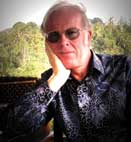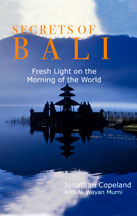About Us
Murni was born in Penestanan, a few minutes’ walk from Ubud. As a very young girl, in the 1950s, she lived in Denpasar, selling breakfast snacks before she went to school.
During the 1960s she was back in Ubud, living with her mother in Ubud market, and learning the trade.
By the early 1970s she owned 4 shops on Sanur beach and had founded Murni’s Warung, her famous restaurant, in Campuan-Ubud, and was on the way to becoming one of the most famous people in Bali.
She built Murni’s Houses, accommodation for guests, and 3 shops in Ubud in the 1980s, and began to travel extensively.
Throughout the 1990s she developed and designed Murni’s Villas in a quiet village in the hills about 15-20 minutes’ outside Ubud.
During all this time she was busy collecting and becoming an expert on Asian antiques and textiles and many of them are to be found in Murni’s Warung Shop beside the restaurant.
In 2007 and 2009 she exhibited part of her collection at the prestigious shows in San Francisco and gave a lecture on Balinese textiles to the Asian Arts Council at the de Young Museum.
Secrets of Bali, Fresh Light on the Morning of the World by Jonathan Copeland and Ni Wayan Murni was published in 2010 and is in its second print run, and is available as an ebook on http://www.murnis.com
Murni’s Very Personal Guide to Ubud by Ni Wayan Murni and photographs by Jonathan Copeland was published in October 2011 and is available as an ebook on http://www.murnis.com, Amazon, iBookstore, Barnes & Noble and elsewhere.
Her latest venture, Tamarind Spa at Murni’s Houses, is intended to bring all these aspects of Balinese art, luxury, and culture together in one healing experience.
Jonathan Copeland was a lawyer and is an independent, freelance photographer and writer specializing in travel photography.
Jonathan Copeland lives in Bali, Thailand and England and travels extensively. He wrote Secrets of Bali, Fresh Light on the Morning of the World, published by Orchid Press in 2010 and is currently working on more books.
Jonathan’s photographs have been published in magazines such as Garuda Indonesia in-flight magazine, Hello Bali, Ubud Live, and Bali and Beyond and newspapers such as the Jakarta Post and The Times, Lombok.
He has contributed photographs to books, such as Dancing Out of Bali by John Coast, Indonesian Food by Sri Owen and The Ethnomusicologists Cookbook edited by Sean Williams.
He has created and maintains several web sites, including Murni’s in Bali (http://www.murnis.com) and Secrets of Bali (http://www.secretsofbali.com) and his photographs are on www.jonathaninbali.com. Videos are on You Tube: JonathaninBali (http://www.youtube.com/user/JonathaninBali)





I love your blog on Bali! 🙂 I love Bali too… The loveliest place on earth 🙂
By the way, can I ask a kind of dim question? Hahah, why is Bali ‘the morning of the world’? Thanks! 🙂
August 8, 2011 at 4:06 pm
Thank you. Delighted that you love the blog. Working on some more posts.
The Indian Prime Minister Jawaharlal Nehru once poetically and
affectionately called Bali, ‘The Morning of the World’.
That’s why we gave it as the sub-title of our book.
August 8, 2011 at 9:20 pm
Dear Murni and Jonathan,
your blog is really interesting, and the pictures are really beautifull.
I’m writing you because i would like to kindly ask information about a ceremony in Bali. I don’t know his name and maybe you can help me discover it. it would be fantastic because i want to came back to bali and spend time studyin for my Ph. Thesis the process of that ceremony. The indications are: A man/woman who want to clean shi/her karma pay the entire ceremony. It start with gamelan, than start the lecture of the Ramayana, and the mask theater while the Pedanda start the ceremony. All together continues along the day. At one moment, while everything goes on, a child is dressed like a God and some people carry him around the village. After that it start the shadow theater and at the end the day finish with traditional plays. The ceremony continues for 18 days long. At the first time i though that was Otonan, but this is the 210days birthay so it may be another ceremony. For me it’s a very important information in order to start planning the trip to Bali and put myself in contact with a village while the ceremony is setteled. I’m really sorry for disturb but i hope you can help me finding the name of this interesting ritual. Thank you so much. Om swastiastu, Alessio
November 29, 2012 at 5:04 pm
Alessio. Thank you. We’re glad that you like the blog and photos. What you have described sounds like an exorcism ceremony, which, although not unknown, is relatively rare, and you are lucky to have witnessed it. We have written at some length about ceremonies generally in Secrets of Bali and you may like to have a look at the relevant chapters in our book. Murni and Jonathan
December 10, 2012 at 7:13 pm